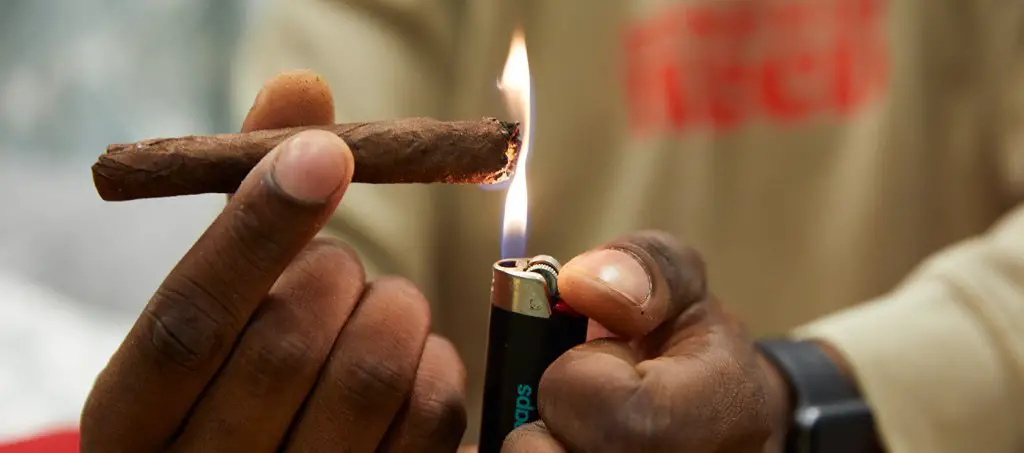Many of you may have heard of honey blunt for the first time. Back in the 80s and 90s, though, it was a fad – a trendy thing to do – to roll and smoke. Since then, it has faded away from the limelight. This old-school technique is still practiced by some people, though there are contradicting viewpoints on safety. Hence, the purpose of this article is not merely to show you how to roll but also to explore its worthiness vs. possible risks.
A part of the fun in consuming weed is finding creative ways to pump THC into the body for that sublime high. As a medicinal user, smoking for relief is probably not a good idea. You’re better off vaping or ingesting edibles. For casual, leisure use, the thought of adding honey to a blunt may sound intriguing. And, if you have never tried it, this notion is novel, and maybe it’s time to find out what’s so special about it.
Page Content
What Is Honey Blunt?
By far, the most popular method of smoking weed is rolling joints. Blunts are different in that the wrap used is made of tobacco leaves. Among the most popular brands are Backwoods and Dutch Masters.

Blunts hold a certain appeal not only because some celebrities smoke it and a trendy thing to do. Instead, the trace amount of nicotine in the leaves gives the perception of a quicker onset and more intense high.
Four decades ago, someone thought of adding honey to traditional blunts. Somehow, it caught on and became a thing.
Why Should You Smoke Honey Blunt?
A regular wrap for joints has a glue strip to seal the paper. That is not the case with tobacco wraps. Ideally, water is used to wet the edges while rolling and sealing. Most people, however, use saliva.
Come to think about it, would you take a puff knowing the blunt has someone else’s saliva?
Honey, as an alternative, takes away the grossness. Not only that, but it also enhances the flavor by adding a sweet note and aftertaste. For most people who smoke honey blunts, though, the primary reason is to slow down the burning as well as eliminating canoeing.
How To Roll Honey Blunt?
It is a no-brainer. Honey blunt is the same as traditional blunts, except for using honey instead of water or saliva.
Here’s how you can do it.
Materials Needed:
- Honey
- Dried bud
- Cigar wrap
- Weed grinder (optional)
- Joint filter tip (optional)
Step 1: Make A Filter
- A raw, unrefined rolling paper tip is suitable. If not available, then you could cut a 1″ x 2″ rectangular strip from a business card. 1″ is the length of the filter and is just about the right size. On the other hand, 2″ represents the girth, and you could play with the size depending on how thin or thick the blunt would be.
- On one end, fold the paper about 1/2 to 3/4 inch from the edge to form a rectangle.
- Hold the small rectangle, keeping it folded, and fold back in the opposite direction.
- Keep the folded rectangles in place, then fold once again from the edge towards the opposite direction. At this point, you have folded three times. If you were to look at the folded paper from the side, it should form a “W” shape with one side longer (the unfolded side measuring 1-1/4″ to 1-1/2″).
- Hold the folded “W” shaped paper with one hand. Using the other hand, hold the unfolded side and start wrapping it around the folded “W.” You can adjust the girth by wrapping loosely or tightly. The size of this filter pretty much determines the thickness of the honey blunt that you are making.
- After wrapping, roll the filter back and forth with your thumb and finger. Once it stays rolled and does not uncoil, you can set it down and start making a honey blunt.
Step 2: Make The Honey Blunt
- Prepare the cigar wrap on the table. Make sure that it is curved. This way, it catches as much of the weed.
- Prepare the herbs by shredding with a weed grinder. If unavailable, then use scissors instead of crushing with fingers.
- Put the filter on one end of the blunt then start filling it with weed. You can use your fingers or anything that could act as a tool, scraping all the herbs into the wrap.
- From one side, roll the wrap around the dried herbs towards the other side. Make sure to pack just enough weed for the two sides to overlap a little, giving it space to adhere to each other.
- You can use water to moisturize the edge or lick and stick. But that defeats the purpose of rolling a honey blunt. Instead, apply a super-thin coating of honey than seal the wrapper.
Notes On Applying Honey:
The procedure shown entails using honey as a replacement for saliva. However, that alone is not enough to slow down the burn rate or prevent canoeing.
Here is something you can do to make a full-fledged honey blunt.
Before packing the blunt with weed, apply a thin coating of honey inside the cigar wrap. Doing so ensures that all sides of the blunt have a honey coating.
Alternatively, you could complete the procedure as described. Once done, apply a thin coat of honey on the exterior of the wrap. Exclude the filter side since that end cannot be smoked. If there are loose weed scattered, you could roll the blunt over it. Those bits and pieces will adhere to the blunt and make it look much more appealing. Kief also works well for this purpose, and it could indeed increase the potency.
Keep in mind that besides applying only a thin coat, the honey should also be evenly spread.
Step 3. Light Up And Smoke The Honey Blunt
After rolling, you should allow some time for the honey to seep into the tobacco wrap and dry a little. If it is too wet, then it’s going to be hard to keep the blunt burning. One way to do that is to put it in the freezer for an hour. After, you can take it out, light up, and enjoy the high complemented by sweet honey flavor and aftertaste.
Is Honey Blunt Dangerous Or Bad For Health?
The jury is out on this one.
Raw honey comprises different types of sugar, water, vitamins, antioxidants, enzymes, and minerals. Pure or processed honey, on the other hand, is heated to 160°F (70°C) and rapidly cooled. It also undergoes rigorous straining to purify. As a result, it looks better and certainly much more appealing but comes at the cost of destroying most of the constituents.
The main concern about heating honey to the point of combustion is sugar caramelization. Unlike vapors that pass through the lungs and the capillaries, there is an insinuation by some people that caramelized sugar may clog the lungs.
The closest study to confirm or dispel that notion is a study published in 2003. Stavanja MS et al. investigated the toxicity of honey as an ingredient added in cigarette casings. Unknown to most smokers, yes, the manufacturers add sugar, among others. After analyzing the data obtained in the experiments, the researchers concluded that:
“Honey, as an alternative casing material in the manufacture of cigarettes, does not alter the potential toxicity of cigarette smoke condensate (CSC) or cigarette smoke.”
Before proclaiming that it is safe, keep in mind that the study compared the use of honey as opposed to invert sugar. Granted that in smoking tobacco and blunt, some sugars are burned already, adding honey may possibly add to the list of toxins and carcinogens produced as by-products of combustion.
Should You Even Roll A Honey Blunt?
At the end of the day, you are solely responsible for yourself. For someone who is already a cigarette or cigar smoker, rolling and smoking a honey blunt is no big deal. Some may be a little more conscious and avoid combusting honey, given that there is an uncertainty on its safety profile.

One could argue that honey is an ingredient that some people use when cooking a dish. In that regard, caramelized sugar goes into the stomach where acids dissolve it – not into the lungs.
At any rate, the decision is yours. Using honey can sweeten the blunt, making it much more palatable. It also slows down the burn rate, thus preserving as much of the weed during idle breaks between tokes. It is up to you to decide if it is worth trying.





